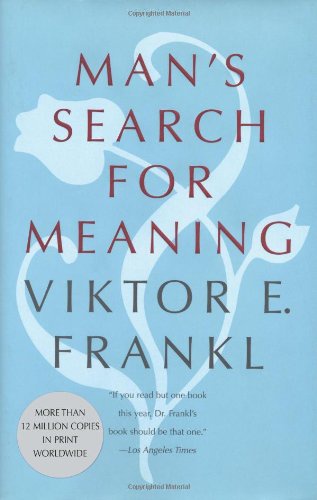Man’s Search for Meaning
by Viktor Frankl

Highlights:
You may be prone to blame me for invoking examples that are the exceptions to the rule. “Sed omnia praeclara tam difficilia quam rara sunt” (but everything great is just as diffcult to realize as it is rare to find) reads the last sentence of the Ethics of Spinoza. You may of course ask whether we really need to refer to “saints.” Wouldn’t it suffce just to refer to decent people? It is true that they form a minority. More than that, they always will remain a minority. And yet I see therein the very challenge to join the minority. For the world is in a bad state, but everything will become still worse unless each of us does his best.
– Page: 125
Most important, however, is the third avenue to meaning in life: even the helpless victim of a hopeless situation, facing a fate he cannot change, may rise above himself, may grow beyond himself, and by so doing change himself. He may turn a personal tragedy into a triumph.
– Page: 118
As logotherapy teaches, there are three main avenues on which one arrives at meaning in life. The first is by creating a work or by doing a deed. The second is by experiencing something or encountering someone; in other words, meaning can be found not only in work but also in love. Edith Weisskopf-Joelson observed in this context that the logotherapeutic “notion that experiencing can be as valuable as achieving is therapeutic because it compensates for our one-sided emphasis on the external world of achievement at the expense of the internal world of experience.”
– Page: 118
To invoke an analogy, consider a movie: it consists of thousands upon thousands of individual pictures, and each of them makes sense and carries a meaning, yet the meaning of the whole film cannot be seen before its last sequence is shown. However, we cannot understand the whole film without having first understood each of its components, each of the individual pictures. Isn’t it the same with life? Doesn’t the final meaning of life, too, reveal itself, if at all, only at its end, on the verge of death? And doesn’t this final meaning, too, depend on whether or not the potential meaning of each single situation has been actualized to the best of the respective individual’s knowledge and belief?
– Page: 117
As for the third issue, addiction, I am reminded of the findings presented by Annemarie von Forstmeyer who noted that, as evidenced by tests and statistics, 90 percent of the alcoholics she studied had suffered from an abysmal feeling of meaninglessness. Of the drug addicts studied by Stanley Krippner, 100 percent believed that “things seemed meaningless.”
– Page: 116
This need for a reason is similar in another specifically human phenomenon—laughter. If you want anyone to laugh you have to provide him with a reason, e.g., you have to tell him a joke. In no way is it possible to evoke real laughter by urging him, or having him urge himself, to laugh. Doing so would be the same as urging people posed in front of a camera to say “cheese,” only to find that in the finished photographs their faces are frozen in artificial smiles. In logotherapy, such a behavior pattern is called “hyper-intention.” It plays an important role in the causation of sexual neurosis, be it frigidity or impotence. The more a patient, instead of forgetting himself through giving himself, directly strives for orgasm, i.e., sexual pleasure, the more this pur- suit of sexual pleasure becomes self-defeating. Indeed, what is called “the pleasure principle” is, rather, a fun-spoiler.
– Page: 113
To the European, it is a characteristic of the American culture that, again and again, one is commanded and ordered to “be happy.” But happiness cannot be pursued; it must ensue. One must have a reason to “be happy.” Once the reason is found, however, one becomes happy automatically. As we see, a human being is not one in pursuit of happiness but rather in search of a reason to become happy, last but not least, through actualizing the potential meaning inherent and dormant in a given situation.
– Page: 112